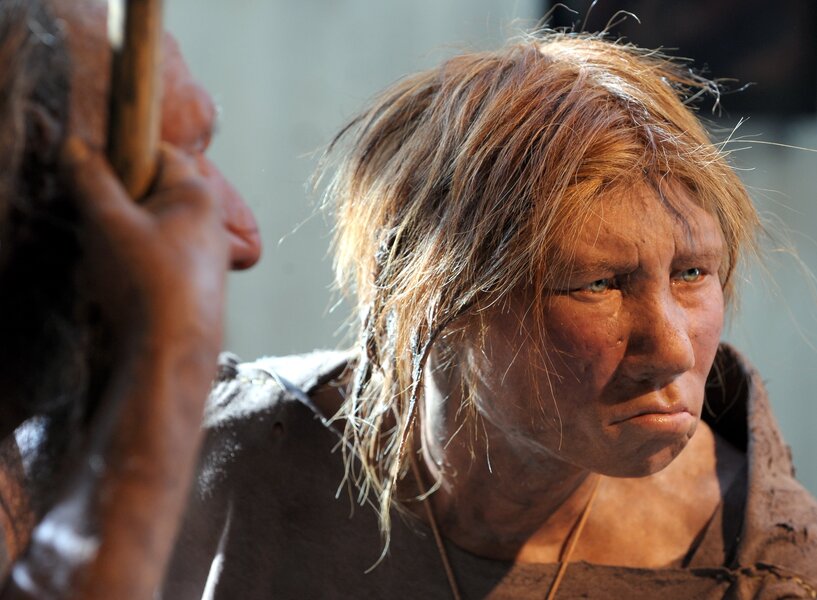Cavemen among us: Some humans are 4 percent Neanderthal
Loading...
We have met Neanderthals, and they are us – or about 1 to 4 percent of each of us.
That is one implication of a four-year effort to sequence the Neanderthal genome – essentially setting out in order some 3 billion combinations of four key molecules that together represent the Neanderthals' genetic blueprint.
So far, the international team reporting the results notes that they've sequenced 60 percent of the Neanderthal genome. And the 60 percent they have – essentially a rough draft – is likely to be rife with errors that will emerge and get corrected over time.
Still, the results mark "just the beginning of an exploration of human uniqueness that it now possible" as anthropologists move beyond fossils to genes in uncovering the story of human evolution, says Svante Pääbo, who heads the Neanderthal Genome Project at the Max Planck Institute for Evolutionary Anthropology in Leipzig, Germany.
Among the tale the genes tell: A few anatomically modern humans mated with Neanderthals, likely in North Africa or the Middle East as modern humans initially were moving out of Africa, the researchers say.
The team came to that conclusion after comparing the Neanderthal genome with those of five humans today: one each from Europe, Asia, and Papua New Guinea, and two from different regions of sub-Saharan Africa. They found that from 1 to 4 percent of the DNA in the genomes of people from Eurasia and the southwestern Pacific were inherited from Neanderthals. Neanderthal-derived genes failed to show up in the African genomes.
'Caveman biology'
The results overturn what Dr. Pääbo calls the "hard out-of-Africa hypothesis" in which a small group of anatomically modern humans migrates from Africa "and replaced everyone else in the world without any admixture." It's entirely possible that African genomes also contain some other form of what Pääbo dubs "caveman biology" from more archaic hominins. "We just don't know that yet," he says.
Nor is it clear yet whether the presence of this DNA in modern humans represents positive selection – genetic material worth holding on to – or biological antiques whose functions have long been lost, the researchers say. So far, the inherited material does not seem to be concentrated in genes, but spread somewhat randomly in non-gene portions of the modern-human genomes.
Whatever the final answer, the question of interbreeding had long puzzled paleoanthropologists, says David Reich, a population geneticist at the Harvard Medical School in Boston and a member of the team reporting the discovery in Friday's issue of the journal Science.
Neanderthals and anatomically modern humans occupied the same general real estate in Europe and western Asia for roughly 50,000 years until the Neanderthals went extinct some 30,000 yeas ago. Scientists have reasoned that there must have been some level of interbreeding during that time.
With these new results, "there's very strong evidence that it did occur. There was gene flow from Neanderthals to the ancestors of all modern non-Africans," Dr. Reich says. The genome comparisons the team performed indicate a small amount of interbreeding that likely occurred during the period when they first came into contact with each other some 50,000 to 80,000 years ago.
Humans, Neanderthals, chimps: three of a kind
The team also compared the genomes of modern humans and Neanderthals to those of chimpanzees – genetically the closet living relative to humans.
Based on the fossil record, the split between chimps' ancestors and those of ancestors of humans and Neanderthals is thought to have occurred some 5 million to 6 million years ago. The split between modern humans and Neanderthals is estimated to have taken place in Africa some 400,000 years ago.
The researchers found that 99.7 percent of the Neanderthal genome is identical to modern humans. Both Neanderthal and modern human genomes are 99.8 percent identical to that of chimpanzees.
The results and their further refinement are expected to yield a treasure-trove of information on what makes modern humans distinct from Neanderthals, humans' closest extinct relative. The team says it already has spotted differences between the two in genes researchers have associated with brain development, skull structure, metabolism, skin types, and wound healing.





